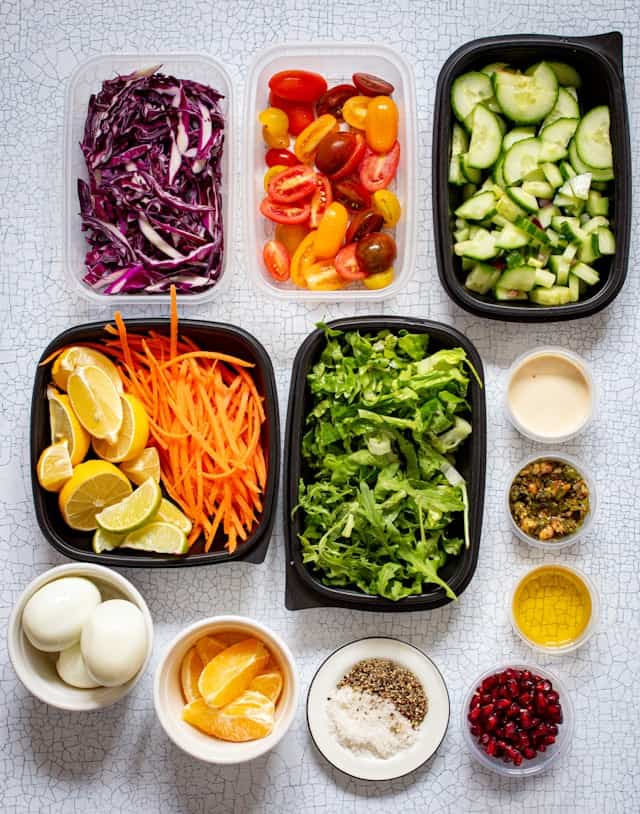Are you looking for a way to optimize your diet and reach your fitness goals? Macro meal planning might be the solution you’ve been searching for. This approach to nutrition involves calculating and tracking your macronutrient intake, which includes protein, carbohydrates, and fat. By doing so, you can ensure that you’re fueling your body with the right balance of nutrients to support your health and fitness goals.
To get started with macro meal planning, you’ll need to determine your daily macronutrient targets based on factors such as your age, gender, weight, and activity level. Once you have this information, you can use a customizable macro meal planner or generator to create meals that fit within your prescribed macronutrient ranges. This can help take the guesswork out of meal planning and ensure that you’re meeting your nutritional needs.
Whether you’re looking to lose weight, build muscle, or simply improve your overall health, macro meal planning can be a useful tool in achieving your goals. By tracking your macronutrient intake and creating meals that fit within your prescribed ranges, you can take control of your nutrition and optimize your diet for success.

Understanding Macro Meal Planning
Macro meal planning is a popular way of eating that involves tracking the intake of three macronutrients: proteins, fats, and carbohydrates. The goal of macro meal planning is to eat within a certain range of these macronutrients each day, which can help with weight loss or maintaining a healthy diet.
To start macro meal planning, you need to determine your daily calorie needs. This can be done using a macro calculator, which will give you the number of grams of protein, fat, and carbohydrates you need each day. Once you have this information, you can begin building a personalized meal plan based on your unique nutritional needs.
When planning your meals, it’s important to keep in mind that each macronutrient has a different number of calories per gram. Proteins and carbohydrates contain 4 calories per gram, while fats contain 9 calories per gram. This means that if you eat equal amounts of each macronutrient, you will be consuming more calories from fat than from protein or carbohydrates.
To balance your macronutrient intake, you should aim to eat a certain percentage of each macronutrient at each meal. For example, a typical macro meal plan might include 40% carbohydrates, 30% protein, and 30% fat. This will ensure that you are getting the right balance of macronutrients without overloading on any one of them.
Macro meal planning can be a great way to improve your overall health and well-being. By tracking your macronutrient intake and building a personalized meal plan, you can ensure that you are getting the right balance of nutrients to support your body’s needs. So if you’re looking for a new way of eating that can help you achieve your health goals, give macro meal planning a try!

Benefits of Macro Meal Planning
Macro meal planning is a popular dieting method that involves tracking the intake of three macronutrients: proteins, fats, and carbohydrates. Here are some of the benefits of macro meal planning:
1. More Flexibility
Macro meal planning allows for more flexibility in your diet. Instead of restricting certain foods or food groups, you can eat whatever you want as long as it fits into your daily macronutrient goals. This means you can still enjoy your favorite foods while staying on track with your diet.
2. Customizable
Macro meal planning is highly customizable. You can adjust your macronutrient goals based on your individual needs and goals. For example, if you’re trying to build muscle, you can increase your protein intake. If you’re trying to lose weight, you can decrease your carbohydrate intake.
3. Helps with Weight Loss
Macro meal planning can be an effective tool for weight loss. By tracking your macronutrient intake, you can ensure that you are in a calorie deficit, which is necessary for weight loss. Additionally, macro meal planning helps you make healthier food choices and avoid overeating.
4. Provides Balanced Nutrition
Macro meal planning ensures that you are getting a balanced diet. By tracking your macronutrient intake, you can ensure that you are getting enough protein, fats, and carbohydrates, which are all essential for optimal health.
5. Improved Athletic Performance
Macro meal planning can also improve athletic performance. By tracking your macronutrient intake, you can ensure that you are getting enough protein to support muscle growth and repair, enough carbohydrates to fuel your workouts, and enough fats for overall health.
In summary, macro meal planning is a flexible, customizable, and effective tool for weight loss, improved nutrition, and athletic performance. By tracking your macronutrient intake, you can ensure that you are meeting your individual needs and goals.

Steps to Create a Macro Meal Plan
Creating a macro meal plan can seem overwhelming, but with a few simple steps, you can easily create a plan that works for you. In this section, we will go over the three main steps to creating a macro meal plan: identifying your nutritional needs, calculating your macro ratio, and choosing your foods.
Identify Your Nutritional Needs
Before you can create a macro meal plan, you need to know your nutritional needs. This includes your daily calorie intake and your macronutrient needs. The number of calories you need each day will depend on your age, gender, height, weight, and activity level. You can use an online calculator to determine your daily calorie needs.
Once you know your daily calorie needs, you can determine your macronutrient needs. Macronutrients include protein, carbohydrates, and fat. Your macronutrient needs will depend on your goals, such as weight loss, muscle gain, or weight maintenance. A typical macro ratio for weight loss is 40% carbs, 30% protein, and 30% fat.
Calculate Your Macro Ratio
Once you know your macronutrient needs, you can calculate your macro ratio. This is the percentage of your daily calorie intake that should come from each macronutrient. To calculate your macro ratio, you can use an online calculator or do it manually.
To calculate your macro ratio manually, you need to know the number of calories per gram for each macronutrient. Protein and carbohydrates contain 4 calories per gram, while fat contains 9 calories per gram. For example, if your daily calorie needs are 2000 and you want a macro ratio of 40% carbs, 30% protein, and 30% fat, you would need to consume 800 calories from carbs (2000 x 0.4 = 800), 600 calories from protein (2000 x 0.3 = 600), and 600 calories from fat (2000 x 0.3 = 600).
Choose Your Foods
Once you know your macro ratio, you can choose the foods you want to eat. It’s important to choose foods that fit within your macro ratio and provide the nutrients your body needs. You can use a macro meal planner or generator to help you plan your meals.
When choosing your foods, focus on whole, nutrient-dense foods such as fruits, vegetables, lean protein, and healthy fats. Avoid processed foods and foods high in added sugars and saturated fat.
In conclusion, creating a macro meal plan is a simple process that can help you achieve your health and fitness goals. By identifying your nutritional needs, calculating your macro ratio, and choosing your foods, you can create a plan that works for you and helps you reach your goals.

Sample Macro Meal Plan
Planning your meals according to your macros can be a great way to achieve your health and fitness goals. Here is a sample macro meal plan to give you an idea of how to structure your meals.
Breakfast
For breakfast, you can have a delicious and nutritious meal that will help you start your day off right. Here is a sample breakfast meal plan:
| Food Item | Portion Size | Carbs (g) | Protein (g) | Fat (g) | Calories |
|---|---|---|---|---|---|
| Oatmeal | 1 cup | 27 | 5 | 2 | 150 |
| Greek Yogurt | 1 cup | 9 | 23 | 0 | 130 |
| Berries | 1/2 cup | 7 | 1 | 0 | 30 |
| Almonds | 1 oz | 6 | 6 | 14 | 160 |
Lunch
For lunch, you can have a satisfying meal that will keep you energized throughout the day. Here is a sample lunch meal plan:
| Food Item | Portion Size | Carbs (g) | Protein (g) | Fat (g) | Calories |
|---|---|---|---|---|---|
| Grilled Chicken | 4 oz | 0 | 36 | 3 | 180 |
| Brown Rice | 1 cup | 45 | 5 | 2 | 220 |
| Broccoli | 1 cup | 6 | 3 | 0 | 30 |
| Avocado | 1/4 medium | 3 | 1 | 7 | 80 |
Dinner
For dinner, you can have a satisfying and delicious meal that will help you wind down after a long day. Here is a sample dinner meal plan:
| Food Item | Portion Size | Carbs (g) | Protein (g) | Fat (g) | Calories |
|---|---|---|---|---|---|
| Salmon | 4 oz | 0 | 25 | 7 | 180 |
| Quinoa | 1 cup | 39 | 8 | 4 | 222 |
| Asparagus | 1 cup | 5 | 3 | 0 | 25 |
| Olive Oil | 1 tbsp | 0 | 0 | 14 | 120 |
Snacks
For snacks, you can have a variety of options that will help you stay on track with your macros. Here are some sample snack options:
- Apple slices with almond butter
- Greek yogurt with berries
- Carrots and hummus
- Hard-boiled eggs
- Protein shake with almond milk
Remember, this is just a sample meal plan. You can adjust the portion sizes and food items to fit your own macros and personal preferences. With a little bit of planning and preparation, you can easily create macro-friendly meals that are both delicious and nutritious.

Challenges in Macro Meal Planning
Macro meal planning can be a great way to achieve your fitness goals, but it can come with some challenges. Here are some common challenges you may face when planning your meals according to your macros:
1. Difficulty in Tracking Macros
One of the biggest challenges in macro meal planning is tracking your macros accurately. It can be time-consuming to weigh and measure every food item you consume, especially when eating out or at social events. Additionally, some foods can be difficult to track accurately, especially when it comes to their macronutrient content. For example, some meats and vegetables can vary in their macronutrient content depending on how they are prepared.
2. Finding the Right Balance
Another challenge in macro meal planning is finding the right balance of macronutrients for your body and your goals. While there are general guidelines for macronutrient ratios, everyone’s body is different, and what works for one person may not work for another. Additionally, your macronutrient needs may change over time as your body composition and fitness goals change.
3. Meal Prep and Planning
Meal prep and planning can also be a challenge in macro meal planning. It can be time-consuming to plan and prepare meals that meet your macronutrient goals, especially if you have a busy schedule. Additionally, it can be difficult to find recipes that fit your macros and that you enjoy eating.
4. Social Pressure
Macro meal planning can also be challenging in social situations. You may feel pressure to eat foods that don’t fit your macros when eating out or at social events. Additionally, it can be difficult to explain your dietary choices to others who may not understand or support your goals.
Overall, macro meal planning can come with some challenges, but with some planning and preparation, you can overcome these challenges and achieve your fitness goals.

Tips for Successful Macro Meal Planning
Macro meal planning can be a game-changer when it comes to achieving your fitness goals. Here are some tips to help you plan and prepare your meals to fit your macros:
1. Calculate Your Macros
The first step in macro meal planning is to calculate your macros. This will help you determine how much protein, carbs, and fat you need to consume each day. You can use an online calculator or consult with a nutritionist to determine your macros.
2. Plan Your Meals in Advance
Planning your meals in advance is key to staying on track with your macros. Take some time each week to plan out your meals and snacks. This will help you avoid making impulsive food choices and ensure that you are hitting your macro targets.
3. Prep Your Meals in Advance
Prepping your meals in advance can save you time and make it easier to stick to your macros. Consider prepping your meals for the week on Sunday or whichever day works best for you. This can include cooking your proteins, chopping your veggies, and portioning out your snacks.
4. Use a Food Scale
Using a food scale can help you accurately measure your portions and ensure that you are hitting your macros. Invest in a good quality food scale and use it to weigh your proteins, carbs, and fats.
5. Focus on Whole Foods
When planning your meals, focus on whole foods that are nutrient-dense and high in protein. This can include lean proteins such as chicken, turkey, and fish, complex carbs such as sweet potatoes and brown rice, and healthy fats such as avocado and nuts.
6. Be Flexible
While it’s important to hit your macro targets, it’s also important to be flexible. Don’t stress too much if you go over or under your macros for the day. Instead, focus on making healthy choices and staying consistent with your meal planning and prep.

Conclusion
Congratulations! You have successfully learned about macro meal planning. Now, you have the tools to create a personalized meal plan that meets your specific dietary needs and goals.
Remember, macro meal planning is all about finding the right balance of macronutrients to fuel your body. It’s not about restricting yourself or cutting out entire food groups. Instead, it’s about making informed choices and being mindful of what you eat.
Here are some key takeaways to keep in mind as you start your macro meal planning journey:
- Determine your daily calorie needs and macronutrient ratios based on your goals and activity level.
- Use a food scale and tracking app to accurately measure and monitor your food intake.
- Choose whole, nutrient-dense foods to meet your macronutrient goals and support overall health.
- Don’t forget to stay hydrated by drinking plenty of water throughout the day.
- Be patient and consistent with your macro meal plan. Results won’t happen overnight, but with dedication and effort, you can achieve your goals.
By following these tips and putting in the work, you can create a sustainable and enjoyable macro meal plan that helps you reach your health and fitness goals. Good luck on your journey!





